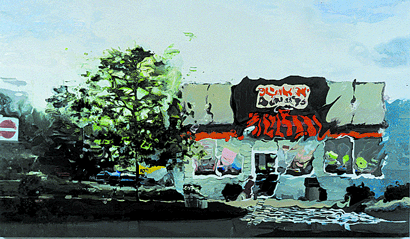A painter’s recent work further explores contemporary American outskirts
Tom McGrath’s second solo exhibition at Zach Feuer’s LFL Gallery is a continuation of the road and automobile exploration he initiated in 2002. While a broad tradition of landscape painting informs the work, its true foundation rests upon a fair amount of heady contemporary urban theory.
In practice, this means that McGrath has set himself the task of translating a lot of ideas into his painterly process—no small undertaking. The artist focuses not so much on landscape per se as the observer’s movement through it. He starts with his own experience on the road as his primary visual model—a driver in flight on American highways in our era of satellite broadband. McGrath paints for an audience accustomed to seeing references to pop culture and appropriated imagery in serious art—not the case when Andy Warhol silk-screened newspaper photos of car crashes onto canvas—which is to say that irony is not the point here. The sensibility is wry, but high-minded.
The show features just five paintings from 2003 and 2004. The canvases are fairly large, in horizontal formats at widths of 96 inches, featuring imagery of cars, parking lots and suburban roadside scenes. However, the pictorial logic of McGrath’s loosely photo-based realist style is continually interrupted by something that makes the scene waver. Is it a time warp? Heavy weather from the fourth dimension rolls down the mountainside and plops on a Dunkin’ Donuts shack…. Other than this striking feature of spatial disruption, which is different in each painting, McGrath keeps it simple.
The paintings have titles such as “Untitled (Dunkin’ Donuts),” “Untitled (car crash),” and “Intersection.” The colors tend toward warm neutral tones of ochre, gray and brown with accents of rich red cadmium and deep viridian green.
In fact, McGrath is far less interested in color relationships than the modulation of space and time through painted form. The viscosity of oil paint is the perfect vehicle, as it were, for McGrath’s ends, and his painterly touch feels full, even fat. Surface textures range from melted plastic to chalk and velvet. The façade of the Dunkin’ Donuts shop wobbles like a pink, orange and brown mirage, as though streaked with rain or the “liquefy” tool in Photoshop had been applied to both architecture and background.
The artist is obliged to support the canvas with a solid board while working to achieve different effects by controlled chance. He stains, sprays, mottles, and allows rivulets of medium to dissolve their way through thick, bog-like islands of paint.
The resulting sense of nonchalance and deliberation is at odds with the idea of rushing highway traffic. The speed of light gets stuck in the muck of the picture plane, where history, perspective and algorithm pile up in instantaneous but inconsistent flows.
McGrath makes photo-collage studies for the paintings using photographs he took himself. They’re destroyed during the painting process, which seems a pity. The difficulty of visualizing what different types of intersecting space might look like is the point of making studies—to have a point of departure for the paintings.
These days, the genre most inclined to explore discontinuous time zones is moving image media, not painting. McGrath’s interest in spatial discontinuity brings him close, at least conceptually, to the work of artists such as Paul Pfeiffer, Douglas Gordon and Theresa Hubbard, all of who reconstruct the space/time continuum somewhere between feature film and applet.
The ambitious overlap of urban theory, his own experience and the painting process is reason enough to see McGrath’s latest exhibition.
gaycitynews.com


































